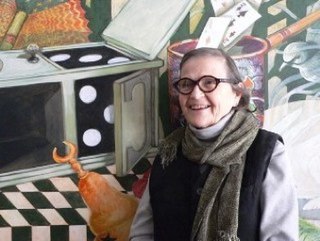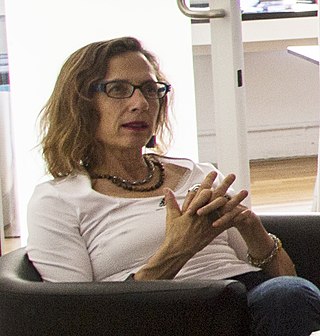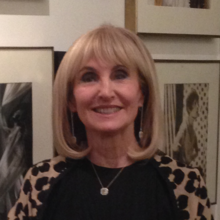Work
In 1983 Sandor formed an artists’ group called (art)n. [7] They created a new art form, called PHSColograms (pronounced “skolograms”), which are 3D barrier-screen computer-generated photographs and sculptures. The term PHSColograms refers to a combination of photography, holography, sculpture and computer graphics. [8] Some of (art)n’s best-known scientific visualizations include a rendering of the AIDS virus cell as well as visualizations of the polio virus, DNA, and the human brain. [9]
Through her Chicago studio, (art)n, Sandor collaborates with artists and technologists to create PHSColograms commissioned by art and science institutions. [10] Sandor’s work has been commissioned by the Jet Propulsion Laboratory, the Smithsonian Institution, and the Tech Museum of Innovation, among others. Her work is held in public and private art collections including the Art Institute of Chicago, the International Center of Photography, the National Academy of Sciences, the Musée Carnavalet, Paris, and the Victoria & Albert Museum, London. [11]
Sandor and (art)n have worked with a variety of artists including Ed Paschke, [2] Karl Wirsum, Chris Landreth, Martyl Langsdorf, Donna Cox, Miroslaw Rogala and Claudia Hart. In addition, she and (art)n have worked with scientists at the Scripps Research Institute, NASA, and the U.S. Army. [12]
Sandor was honored by the Bulletin of the Atomic Scientists for her longstanding commitment to integrating art and science in 2017. [13]
She is co-editor and contributor to New Media Futures: The Rise of Women in the Digital Arts (2018) published by the University of Illinois Press. [14]

Mariko Mori is a Japanese multidisciplinary artist. She is known for her photographs and videos of her hybridized future self, often presented in various guises and featuring traditional Japanese motifs. Her work often explores themes of technology, spirituality and transcendence.

Richard Howard Hunt was an American sculptor. In the second half of the 20th century, he became "the foremost African-American abstract sculptor and artist of public sculpture." Hunt, the descendant of enslaved people brought from West Africa through the Port of Savannah, studied at the School of the Art Institute of Chicago in the 1950s. While there he received multiple prizes for his work. In 1971, he was the first African-American sculptor to have a retrospective at Museum of Modern Art. Hunt has created over 160 public sculpture commissions, more than any other sculptor in prominent locations in 24 states across the United States.

Joseph Nechvatal is an American post-conceptual digital artist and art theoretician who creates computer-assisted paintings and computer animations, often using custom computer viruses.

Ruth Duckworth was a modernist sculptor who specialized in ceramics, she worked in stoneware, porcelain, and bronze. Her sculptures are mostly untitled. She is best known for Clouds over Lake Michigan, a wall sculpture.

PHSCologram is a registered trademark for barrier-strip and lenticular autostereograms made by Chicago-based art collective (Art)n laboratory.
Jane L. Calvin is an artist based in Chicago, Illinois.
Jacob Ciocci is an American visual artist, performance artist, musician, and professor. Along with sister Jessica Ciocci and friend Ben Jones, he was one of the three founding members of Paper Rad, an artist collective active from 2000 until 2008. He performs and tours regularly with drummer David Wightman in the band "Extreme Animals". As of 2015, he is based in Brooklyn, New York.
Sanford Biggers is an American interdisciplinary artist who works in film and video, installation, sculpture, music, and performance. A Los Angeles native, he has lived and worked in New York City since 1999.

New media art includes artworks designed and produced by means of electronic media technologies. It comprises virtual art, computer graphics, computer animation, digital art, interactive art, sound art, Internet art, video games, robotics, 3D printing, immersive installation and cyborg art. The term defines itself by the thereby created artwork, which differentiates itself from that deriving from conventional visual arts such as architecture, painting or sculpture.

Ellen Harvey is an American-British conceptual artist known for her painting-based practice and site-specific works in installation, video, engraved mirrors, mosaic and glass. She frequently pairs traditional representational vocabularies and genres with seemingly antithetical postmodern strategies, such as institutional critique, appropriation, mapping and pastiche. Her work examines such themes as art as a mirror, interactions between built environment and landscape, ruins and the Picturesque aesthetic, and cultural and economic relationships between museums, artists and publics. Curator Henriette Huldisch writes of her work, "haunted as it is by the notion of art's ultimate futility, her paradoxical stake is in persistently testing art's possibility to do something in the world after all."

Ellen Lanyon was a painter and printmaker from Chicago, Illinois. She received her BFA from the School of the Art Institute of Chicago (SAIC), her MFA from the University of Iowa School of Art and Art History and studied restoration at the Courtauld Institute of Art. She also received an honorary doctorate from SAIC. Her works are in the permanent collections of many major American museums, including the Art Institute of Chicago, the Museum of Contemporary Art Chicago, the Metropolitan Museum of Art, the Smithsonian American Art Museum, and the Ulrich Museum.

Heather Dewey-Hagborg is an information artist and bio-hacker. She is best known for her project Stranger Visions, a series of portraits created from DNA she recovered from discarded items, such as hair, cigarettes and chewing gum while living in Brooklyn, New York. From the extracted DNA, she determined gender, ethnicity and other factors and then used face-generating software and a 3D printer to create a speculative, algorithmically determined 3D portrait. While critical of technology and surveillance, her work has also been noted as provocative in its lack of legal precedent.

Andrea Polli is an environmental artist and writer. Polli blends art and science to create widely varied media and technology artworks related to environmental issues. Her works are presented in various forms, she uses interactive websites, digital broadcasting, mobile applications, and performances, which allows her to reach a wider audience.
Randolph Street Gallery (RSG) was an alternative exhibition space in Chicago, Illinois, from 1979 until its closing in 1998 and a vital local force in the development of a variety of new art forms and the contemporary national and international arts milieu. Founded by two artists, Tish Miller and Sarah Schwartz, RSG began in Schwartz's living room, later moving to 853 W. Randolph Street on Chicago's west side. The late 1970s, was a period when young artists in all disciplines were collectively founding visual and performing art organizations as alternatives to mainstream and commercial venues in many US cities. RSG was one of more than a dozen 'alternative' galleries - along with many new 'alternative' theatre groups - situated on the near north and west sides of Chicago. The gallery’s focus was on the needs of artists and practitioners who created work that was unsupported, or at the time, perceived to be unsupportable by most commercial or institutional funders. Randolph Street Gallery was also the locus for groundbreaking collaborative projects such as The File Room: An Archive on Cultural Censorship, conceived by Antoni Muntadas, and was the publisher of P-Form: Performance Art Magazine.

Claudia Hart is an artist and associate professor in the Department of Film, Video, New Media, Animation at the School of the Art Institute of Chicago, Chicago, Illinois. She has been active as an artist, curator and critic since 1988. She creates virtual representations that take the form of 3D imagery integrated into photography, animated loops and multi-channel animation installations.
Brooke Singer is a New York City–based media artist, co-founder of the art, technology and activist group Preemptive Media, and a professor of New Media at Purchase College, State University of New York. She works across disciplines engaging technology and science as an artist, educator, and collaborator. Her work exists in the form of websites, photography, maps, installations, workshops, and performances that involve public participation with an eye to social change.

Jennie C. Jones is an African-American artist living and working in Brooklyn, New York. Her work has been described, by Ken Johnson, as evoking minimalism, and paying tribute to the cross-pollination of different genres of music, especially jazz. As an artist, she connects most of her work between art and sound. Such connections are made with multiple mediums, from paintings to sculptures and paper to audio collages. In 2012, Jones was the recipient of the Joyce Alexander Wien Prize, one of the biggest awards given to an individual artist in the United States. The prize honors one African-American artist who has proven their commitment to innovation and creativity, with an award of 50,000 dollars. In December 2015 a 10-year survey of Jones's work, titled Compilation, opened at the Contemporary Arts Museum in Houston, Texas.
Jane Veeder is an American digital artist, filmmaker and educator. She is a professor at San Francisco State University in the Department of Design and Industry, at which she held the position of chair between 2012 and 2015. Veeder is best known for her pioneering work in early computer graphics, however she has also worked extensively with traditional art forms such as painting, ceramics, theatre, and photography.
Barbara Sykes into a family of artists, designers and inventors. Since childhood, she has produced work in a variety of different art forms. In 1974, she became one of Chicago's pioneering video and new media artists and, later to include, independent video producer, exhibition curator and teacher. Sykes is a Chicago based experimental video artist who explores themes of spirituality, ritual and indigeneity from a feminist perspective. Sykes is known for her pioneering experimentation with computer graphics in her video work, utilizing the Electronic Visualization Laboratory at the University of Illinois, Chicago, at a time when this technology was just emerging. Her early works broke new grounds in Chicago's emerging New Media Art scene, and continue to inspire women to explore experimental realms. With a passion for community, she fostered significant collaborations with many institutions that include but are not limited to University of Illinois, School of the Art Institute of Chicago, Columbia College, Center for New Television, and (art)n laboratory. These collaborations became exemplary for the showcasing of new media work. The wave of video, new media and computer art that she pioneered alongside many other seminal early Chicago New Media artists persists as a major influence for artists and educators today. Her work has been exhibited internationally, at institutions such as Moderna Museet (Stockholm), Ny Carlsberg Glyptotek (Copenhagen), Musée d'Art Moderne de la Ville de Paris, Museum of Contemporary Art San Diego, Metropolitan Museum of Art , Museum of the Art Institute (Chicago), The Metropolitan Museum of Art and SIGGRAPH. Sykes's tapes have been broadcast in Sweden, Italy, Puerto Rico and extensively throughout in the US, including "The Independents", PBS national broadcast, 1985, and national cablecast, 1984. Media Burn has an online selection of her tapes and over 200 of her raw footage, master edits, dubs and compilation tapes in their Independent Video Archives @ Barbara Sykes https://mediaburn.org/collections/videomakers-page/barbara-sykes/. Select grants include a National Endowment for the Arts and American Film Institute Regional Fellowship, Evanston Art Council Cultural Arts Fund and several Illinois Arts Council grants. In 2017, Sykes began to paint. In 2020, as the recipient of an Evanston Art Center Individual Artist Exhibition Award, Ethereal Abstractions, Sykes's first solo watercolor exhibition premiered 81paintings and she gave an online Artist Talk. Her paintings are lyrical, colorful abstractions reminiscent of organic shapes, ethereal forms and underwater landscapes - evocative impressions of spiritual and elemental worlds. They evoke the spontaneity and themes that have evolved from her previous body of time-based and digital artwork. In 2021, she moved to Florida. Her 2022 painting exhibitions/reviews include Forces of Nature showcased on the cover of Estero Life Magazine and she is in the article, Beholding Beauty: Artists of Estero Exhibit at COCO Art Gallery, the Florida Watercolor Society's 2022 Online Show, the 36th Annual All Florida Exhibition and Connections Art in Flight exhibit at the Southwest Florida International Airport, June 2022 to June 2023. She paints under the name of Barbara L. Sykes.
Torkwase Dyson is an interdisciplinary artist based in Beacon, New York, United States. Dyson describes the themes of her work as "architecture, infrastructure, environmental justice, and abstract drawing." Her work is informed by her own theory of Black Compositional Thought. This working term considers how spatial networks—paths, throughways, water, architecture, and geographies—are composed by Black bodies as a means of exploring potential networks for Black liberation. She is represented by Pace Gallery and Richard Gray Gallery.












